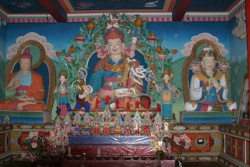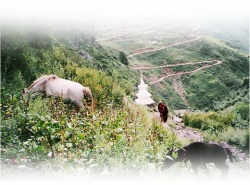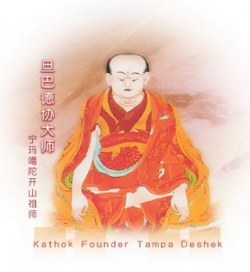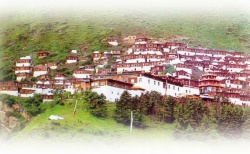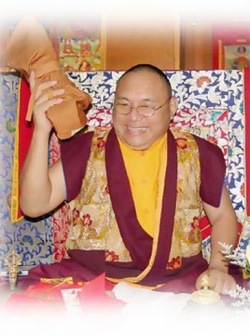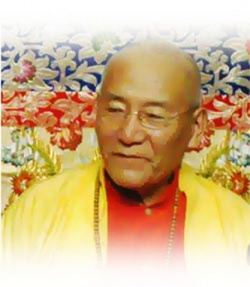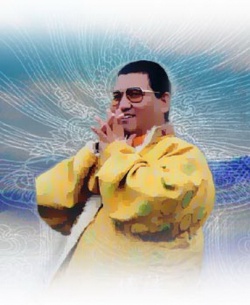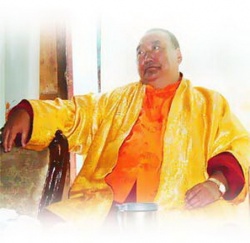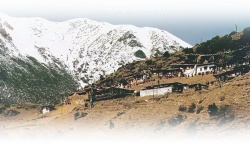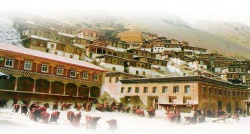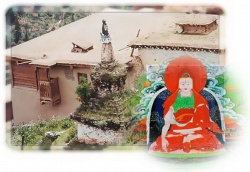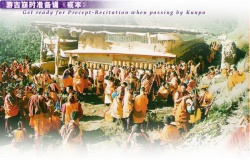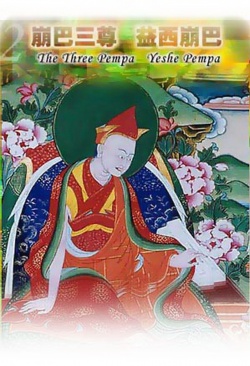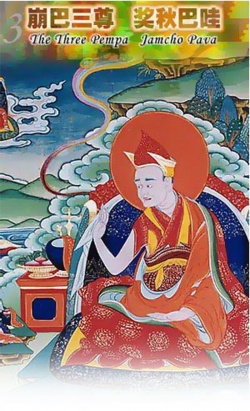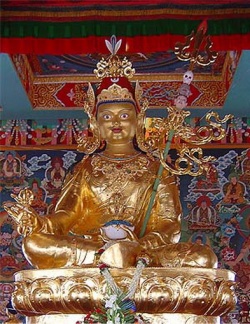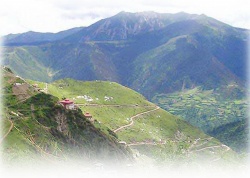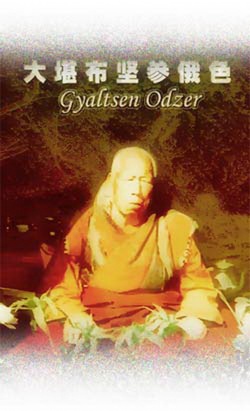Kathok Nyingma Tradition of Tibetan Buddhism
It is well known that Tibetan Buddhism is divided into the four Great Traditions of the:
1 Nyingma
2 Kagyu
3 Gelug
4 Sakya
Under each Tradition, there existed different sub-traditions. In the Nyingma Tradition, there are six sub-traditions:
1 Kathok
2 Palyul
3 Dzogchen
4 Shechen
5 Mindroling
6 Dorje Drak
The sub-tradition of Nyingma Kathok is the source of all the other sub-traditions and historically, it is the oldest of all traditions of Buddhism in Tibet.
The main monastery of Kathok is located in the Si Chuan Province, White Jade County - Ho Po region (Derge), a pure land where all the people embrace the Teachings of Lord Buddha. The monastery is situated at the middle of the Bai Long Gou (White Dragon Channel) on Do-Nian Mountain.
It was found by the great Nyingma Master Tampa Deshek in Year 1159.
The full name of the monastery is Kathok Dorje Den (Ga Tuo.Duo Ji Dan) named so because the monastery is built on top of a naturally-arisen "Ga" letter on a huge and smooth white-coloured stone.
"Dorje Den" in Tibetan means "Vajra Seat", the holiest place for Buddhist all over the world, the very place where Lord Buddha manifested the Great Enlightenment.
Great Guru Padmasambhava declared that the blessings of Kathok would reign supreme and is equivalent to that of the Vajra Seat in Bodhigaya on which Lord Buddha attained Enlightenment. Guru Rinpoche personally consecrated Kathok Monastery 13 times and prophesied Kathok to be The Supreme Holy Place of the Snowy Lands, The Ultimate Source for the Dissemination of the Vajrayana Teachings of the Great Dakini Yeshe Tsogyal.
100,000 Rainbows of Kathok
Relying upon the unique Kathok's esoteric practices of the Dzogchen Zuktor Sangwai Mengag, Dzogchen Semde Deun Poa and 13 other great volumes of precious Teachings, there have, from the founding of Kathok to the present time of Ya La Bai Ma Deng Du, had 100,000 practitioners who attained the highest enlightened stage of Rainbow-body. The holy place containing the foot-prints of 100,000 dakinis are still clearly visible on Mountain Duo Nian today. The unsurpassable blessings of the holy Kathok Nyingma Tradition are unique.
The Kathok Nyingma Lineage is analogic to the essence of the refinest of gold. In the centuries of Kathok's history, there have been a total of 123 accomplished masters from the time of the Kathok Great founder Tampa Deshek to:
the 80th Throne-holder Kathok Tai Situ Chokyi Gyaltsen Rinpoche, Situ Rinpoche's students, include the great Khenpo Lei Xia Deng, Jamyang Khyentse Chokyi Lodro Rinpoche, Geze Rinpoche, Deng Be Namjia Rinpoche, great Khenpo Gyaltsen Ozer and other great masters.
From the great Khenpo Gyaltsen Ozer Rinpoche, the Holy Throne-holder of Kathok was passed on to Mocha Rinpoche and Dimed Shing Kyong Rinpoche, the 83rd Throne-holder of Kathok.
Now, the glorious seat of the Kathok Nyingma Lineage is occupied by the H.H. Lhoga Rinpoche as the 84th Supreme Throne-holder of Kathok.
From the great Guru Padmasambhava, the H.H. Lhoga Rinpoche would be considered as the 99th Absolute Lineage-holder of the Nyingma Tradition. Presently, many rinpoches from the main Kathok Monastery are diligently spreading the Kathok Nyingma's Teachings of Lord Buddha for the benefit of mother sentient beings everywhere and are duly recognised through the precious instructions of the:
..great Khenpo Jamyang and other great masters
..the noble Dimed Shing Kyong Rinpoche
..H.H. Mocha Rinpoche
..Ge Ze Rinpoche
..Chadral Rinpoche
..Jiang Yang Tulku and so on.
However, owing to the great number of affiliated monasteries of Kathok, it is virtually impossible to list out of all the great masters.
Nevertheless, accomplished prominent masters of Kathok who propagated the Dharma overseas are as follows:
..Chadral Rinpoche ..Bairo Tulku Rinpoche
(the younger brother of H.H. the Mocha Rinpoche; the father of the present H.H. Gyalwang Drukchen Rinpoche, the supreme head of the Drukpa Kagyu Tradition)
..Kathok Tai Situ Rinpoche
..Weng Chu Rinpoche
..Yanpan Sherap Gyaltsen (Karma Rinpoche
(the present 85th Kathok Lineage Throne Holder, - previous life was Xire Jiangcan, one of the 3 Immediate Enlightened Ones.)
..Chagdud Tulku Rinpoche .. Nyoshul Khen Rinpoche .. Wei Yin Tulku and other likewise noble masters.
Kathok Monastery at present
For hundreds of years, the Kathok Nyingmapas had monasteries all over Tibet, Bhutan, India, Sikkim, Mongolia as well as China. During the ancient times, there were over 300 monasteries but many were in ruins.
However, thanks to diligent reconstruction efforts in recent years, there are now a total of 130 monasteries still existing. The great Khenpo Gyaltsen Ozer; Mocha Rinpoche; Jung Rinpoche as well as H.H. Lhoga Rinpoche have been incessantly working hard to revive the once extremely vibrant Kathok Tradition. They rebuild many Kathok holy temples, monasteries, Buddhist colleges and meditation retreat centers.
In particular, they oversee the reconstruction of the magnificently spectacular holy mandala of the Auspicious Copper-Coloured Mountain, the Pure-land of Padmasambhava, so that it would once again be a holy place for everyone everywhere.
Kathok Buddhist University
The Kathok Buddhist University is the highest institution of learning in the Kathok Nyingma Tradition. The entire course stretches for a period of 5 years. Monks who aspire to continue their studies at Kathok Buddhist University have to first graduate from their own local Buddhist institutions before they are allowed to pursue their post-graduate studies at Kathok Buddhist University.
At the full completion of their studies at Kathok Buddhist University, they will be awarded the title of "Khenpo" in the Kathok Nyingma Lineage.
The 5 years course consists of the following:
..Nagarjuna's 6 Commentaries on Madhyamika
..Dawa Dralgon Gateway to Madhyamika
..Arya Dala's 400 Commentaries on Madhyamika
..Maitreya's 5 Commentaries and many other hundreds of texts
Their courses emcompasses:
religious studies ..arts .. medical sciences ..astrological studies..craftsmanship..linguistic syntax ..philosophy and semantic phonology
Presently, there are approximately 200 students in Kathok Buddhist University. As the university's maximum residential capacity is only for 50 persons, the other 100 over students have to be temporarily lodged at the retreat centers. Work for the expansion of the university residential facilities has been stalled indefinitely due to the lack of financial funding. Kind contributions at this period are crucial to the continuation of Kathok Nyingmapa's illustrious lineage, so that the students can put in their heart and soul to study buddhism.
2 Centre for Meditation Retreat
This is where the Kathok Nyingmapas preserve their highest and most esoteric practices. The Centre is divided into:
1 Ringung
2 Zha Dong colleges
In addition to these two colleges, there are also other affiliated retreat centers. The Center is lead by 2 greatly erudite and accomplished masters; Their Holinesses, the Mocha and the Lhoga Tulkus. Besides, there are also many other highly attained masters who act as the Center's Teachers. A retreat at the Center takes 3 years, 3 months and 3 days. During the course of the retreat, the aprticipants are expected to complete Ngondro or the 500,000 Preliminary Practices. Moreover, they must undergo the practices of:
..Guru Padmasambhava's Peaceful and Wrathful Practices
.. Vajrakilaya
.. the 8 Great Practices
.. the Collection of Secrets
.. the Lion-faced Dakini
.. the Great Enemy of Death (Yamantaka)
.. Varjasattva
..the Hundred Peaceful & Wrathful Deities of the Bardo and other such profound practices.
They must accomplish the required number of mantras of each of the karma and terma teachings of the 16 mandala's "3 Roots" (the Guru, the Yidam and the Dakini).
In addition, they must accomplish:
..the Phowa Practices
.. the Tsa-lung Practices of the Winds, Channels, Rows as well as
.. the Dzogchen Practices of the Trekcho and
.. the Togyal
Upon successful completion of the retreat and due recognition from the centre's Teachers, the students could then be bestowed the title of "Vajra Acharya". The most highy-realised of the Vajra Acharyas could then be chosen to become the abbots of the affiliated monasteries.
Future International HQ of Kathok Nyingmapas
Chadral Rinpoche is presently the most accomplished yogi living in Nepal. The Rinpoche had acquired a huge piece of land at Pharping, one of Nepal's most holy places. The Rinpoche intended the land to be the future international headquarters of Kathok Nyingma centres all over the world and collaborating with the main Kathok Monastery in Tibet, to be known as the Western Kathok Monastery. Chadral Rinpoche officially invited H.H. Lhoga Rinpoche to be the headquarters Chief Abbot and to guide all construction operations as well as to oversee all the activities of spreading the holly Teachings of Lord Buddha. This would become the greatest of holy places for dharma practitioners everywhere and the focal point where the Kathok Nyingmapas will spread forth in the world.
King of Sacred Land - Kathok Monastery
The great master Vairocana (see below) stayed at Kathok for a whole month while he was at Gyarong. The first lineage master of Kathok, Tampa Deshe, too, practised at Kathok in a cave known as Tampo.To the left of Kathok Monastery is a place known as Kunpo. It is regarded as a place of 100,000 Buddhas. At Kunpo, the accomplished master Vairocana constructed a stupa. This stupa is thought to be effective in subduing a demoness. It is considered by ancient geomancy masters to be similar to Tibet's own land-shape. In addition, Kunpo is also the reliquary of many lineage masters.
Land of Rainbow
The Holy Place of Kathok is the most sacred amongst the 108 holy places. Kathok is known as the "Second Mandala" meaning the second Bodhigaya where Lord Buddha manifested the Great Enlightenment.The spread of Kathok's Teachings marked an unprecedented flourishing of the Dharma. At the time of the fifth Throne-holder Yeshe Pempa, 100 out of over 180,000 monks attained the rainbow body.
Rainbow Body is a sign of the highest attainment.
It is a stage where the practitioners have totally merged their physical bodies with the primordial Buddha-nature of Voidness and Absolute Clarity. The Rainbow Body is non-dual with a Buddha's clear light Dharmakaya. Such practitioners could transform their entire body into rainbow light, totally merged into Voidness.
Although these practitioners may not be famous when alive, they, nevertheless, upon nirvana, would have actualised the stage of Buddhahood, leaving only their hair or nails as a source of merit for disciples.
These fairy tale-like occurrences are common within the Kathok Lineage with reports of over 100,000, even in the present era. These practitioners' sincerity, humbleness and diligence are living proof to the world of the authenticity of the holy Dharma.
According to legendary accounts, at the time of arduous construction of the Kathok Monastery, a man deliberately donated a fleece of 1,000 sheeps, hoping that the constructors would commit the unskilful acts of killing. To the surprise of all, the then Throne-holder, Jamcho Pawa, approved to the slaughter of all the 1,000 sheeps for food. At the end of the feast, Jamcho Pawa instructed them to assemble the skins and bones of the sheeps.
Jamcho Pawa faced the heap of bloody remains and at the click of his fingers, the sheeps were instantaneously "revived" , some grazing, others bleating, everything to the utter amazement of all present. At the next click of the fingers, all the sheeps transfigured into rainbows, one following another, took rebirth into the Pure Land of Great Bliss.
At one time, the Kathok Monastery was greatly desecrated. To the great astonishment of everybody, the 1,000 sheep skins left behind from yonder years were discovered enshrined within the stupas in Kathok. The legend proved to be true after all!
At the time of the 6th Throne-holder of Kathok Jamcho Pawa, over a hundred monasteries and temples were constructed. The entire mountain of Kathok was totally occupied by holy temples, monasteries and monks' quarters.
To expand further, it becomes necessary to build on mountains far behind Kathok. The great number of Sangha members completely filled up the majestic mountains of Kathok. Donning their robes of red and yellow, the holy Sangha flutter amidst the expansive wilderness of mountainous startling jade. Reflected against the gentle blues of the horizon, brilliant masses of light illuminated upon the sky – a scenery of embellished beauty.
The Kathok Teachings pervaded the whole of Tibet, Nepal, India, Mongolia, the ancient kingdom of Da Li, the Five Peak Mountains of Shan Xi and other places in mainland China. Determined at the time of Tampa Deshek, the Kathok Tradition mainly relied upon the following Teachings : Maha/Anu & Atiyogas
The 3 main tantric texts of the Generation, Completion and Great Perfection stages:
The Sutra section
The Collection of Secrets Sutra
The Commentary Section
The Guhyagarbha Tantra
The "Heart" Section
Heart Section - 18 mother and son sutras
Besides, there are tantras of the Guhyasamaja, Chakrasamvara, Hevajra, Kalachakra and the like.
On the teaching of the sutra section, it is done on a large scale, teaching and practising en masse. At this level, many practitioners attained enlightenment. On the teaching of the tantra and "heart" section, it is done through the methods of the profound pith-instructions and ear-whispered tradition. This form of unsurpassed manner of transmitting the teachings is relatively more profound than the latter and is the formal introduction to the Kathok Tradition's inconceivable attainment and unbelievable practices that produces 100,000 rainbow bodies.
During the time of Mani Renchen
Besides transmission of the sutras, the tradition of the termas of the 2 accomplished masters, Yang and Gu were also introduced.
During the time of Zhong Namka Shenge
The Kathok Tradition started the practices of the termas of Ratna Lingpa.During the time of Duddul
Longsar Nyingpo, the Kathok Tradition greatly propagated the Northern Tradition of the termas of Karma Lingpa's [[100 Peaceful and Wrathful[Bardo Deities]], The Guru's collection, as well as 9 other different profound practices.
During the time of Xi Du Qiu Ji Xing Gei
As a disciple of the lineage master Jigme Lingpa, he incorporated the Longchen Nyingthig Teachings into Kathok.
There have been a total of 13 great texts, comprising of both the karma and terma lineages, from the time of Tampa Deshek. These 13 texts are the main practices. Together with the source for the attainment of the rainbow body in the Kathok Tradition through the centuries, they are collectively known as the Profoundly Unique 13 Great Teachings:
These 13 great teachings are :
1
The Great Master, Zhang Dong Jie Master
The Rosary of Pith-Instructions for Attainments
2
Namka Dorje
Essential Heart Commentary]]
3
Misho Sangje Dorje
Essential Heart-drop of the Guru
4
Yeshe Gyaltsen
The Ocean of Oral-instructions of Mahamudra
5
Gongde
"Chod" Great Commentary
6
Tashi Renchen
The Mirror of Profoundity and Wisdom
- Commentary of Dzogchen
7
Gushali Sonam Dromjo
The Essence of Inconceivable Meaning
- Commentary of Dzogchen
8
Hopo Chadral Jia Gyaltsen
The Commentary on the Direct Path to Realisation
9
Padma Made
The Teachings on Bardo of the 6 Realms
10
Renchen Chewang Norbu
The precious collections of
11
Padma Made
The Deep Path - The Clear Meaning]]
12
Duddul Dorje
The Teachings of Dzogchen - Samantabhadra's rainbow body
13
Longsar Nyingpo
Jawad Dosel (Phowa)
In recent years, a great accomplished master, by the name of Gei Ze Jiu Mei Dang Ba Nan Jie, aggregated the essence of the above 13 great texts into a compound volume known as "The Precious Mirror – The Door of Skilful Teachings". This precious volume becomes an extremely important text as a guide and source of reliance for practitioners.
With the progress of time, many practitioners of Kathok left the monastery to establish their own traditions.
During the time of Longsar Nyingpo
There are over 1,000 monks.
During the time of Situ Choje Gyaltso[
There are over 3,000 monks.
the floating Lotus Palace
Although the number of monks has dwindled, the Kathok Monastery still retains many priceless holy objects:
the hand-manuscripts of the past Lineage-holders of Kathok
the wood-block compositions and termas
the entire hand-copied version of the Tripitaka, written in gold ink
the huge Buddhist images
numerous indescribably excellent Buddhist images and
holy objects of divine origin..
such as the Supreme Spiritual-Teacher of the Yuan Dynasty, Ba Si Ba's (Sakya Drogon Chogyal Phagpa) gift –
.. a 3-storey high bronze Buddhist Stupa, totally covered with gold.
This stupa is Ba Si Ba's expression of gratitude to his Guru, the 5th Throne Holder of Kathok, Yixi Beng(pa) for the great Initiation of the 100-Dieties of the Bardo – the Guhyagarbha Tantra;
.. the Buddhist stupa made of glass is a gift from the King of Da Li, within which is a Buddha image made of pure gold and a 3-dimensional ivory mandala;
.. the 7 great offerings – receptacles measuring 3 metres in diameter; a Shakyamuni Buddha Image that is the most precious holy object of India's "Wu Dan Da Bo Li" temple.
The most spectacular of these holy objects is the greatly famous Mandala of Padmasambhava – the Auspicious Copper-coloured Palace.
Outside view is that of a 5-storey-high magnificently spiendorous palace.
Inside view is that of the great hall of the mandala and the Buddha Statues of the 3 Holy Bodies of the Emanation-Body, the Enjoyment-Body and the Truth-Body.
All the wall-paintings and sculptures are very life-like. To be in the mandala would make one feel as if one is dwelling in the Pure Land of Great Bliss.
The great hall's stone walls, stone pillars and roof tiles are all plastered with gold as thick as the skin of a horse.
There are also exquisitely crafted golden umbrellas, canopy, auspicious Dharma Wheel flanked by a buck and doe as well as the paragonic pinnacle, treasure vase and countless other sumptuous awe-inspiring holy objects as well as many beautiful artistic treasures.
However, the Law of Impermanence applies even with the presence of Dharma. The 4 processes of Impermanence: Creation, Preservation, Destruction, Return to its primordial nature of Voidness
...which fell inconspicuously upon such a wondrous and superior holy place of the majestic Kathok Monastery.
In the ancient times , there are 300 over Kathok Monasteries flung across Tibet, Bhutan, Sikkim, Mongolia, the ancient kingdom of Da Li and China proper. With the lapse of time, there are only about 130 Kathok Monasteries left even with ardent re-construction efforts.
Until the time of the 80th Throne-Holder Xi Du Que Jie Jiang Can Rinpoche in recent years.. there have been a total of 123 totally accomplished masters. The successors of Situ Chokyi Gyaltso include Mocha Rinpoche, Kyong Jung Rinpoche and the late great Khenpo Gyaltsen Ozer who also happened to be the 83rd Throne-Holder. After 10 years of wild turmoil, the Holders of Kathok's Golden Dharma Throne: .. H.H. Mocha Rinpoche, Kyong Jung Rinpoche, great Khenpo Gyaltsen Ozer and supreme head of Kathok Monastery, H.H Lhoga Rinpoche.
They lead all students in a hard drive to revive the Kathok Tradition. They unceasingly re-constructed the many Kathok temples, monasteries, monks' quarters, a Buddhist University, 2 meditation centres as well as continuing with the re-building of the magnificently inspiring Copper-Coloured Palace so that it will once more serve as the ordained and laymen's holy place of refuge. Thus, the holy monastery was resurrected from the ruins.
Thousand's Sanghas' Gathering
In recent years, like a lion who returns from afar to exert his mighty strength , the mythological fragrant elephant who returns from the muddy marshes to resume its sacred footsteps, the Kathok Tradition perseveres in the important and far-reaching task of propagating the Dharma for the benefit of all sentient beings.
In 1992, from the 1st to the 10th day of the Sixth Month of the Monkey Year according to the Tibetan Calendar, a Thousand Sanghas' Gathering was held. There was altogether the use of 16 different mandalas for the turning of the Holy Wheel of Dharma. 3,600 Sangha members as well as tens of thousands of laymen gathered in Kathok to participate in the event.
In 1995, from the 1st to the 10th day of the Sixth Month of the Pig Year according to the Tibetan Calendar, a grand "10,000 Sanghas' Gathering" was held. There were over 10,000 Sangha participants from the branch monasteries of Kathok and others who have derived benefits from receiving the transmission of the Kathok lineage. Overseas participants who came all the way from China and abroad numbered to over a hundred thousand. Also present were nectar pills that were specially blessed.
The accomplished practitioners and the various Buddhist followers who have received the nurturing milk-like teachings of Kathok, with vast and unlimited compassion and with the magnificence of the Dharma, benefited unlimited sentient beings from all over the world. The stream of the excellent Kathok Tradition's blessings was transmitted from the founder Tampa Deshek to the present Mo-zha Rinpoche and H.H. Lhoga Rinpoche. Through their vows and learnings, together with the Kathok Tradition's strict practising and accomplishments, their authentic heart-essence teachings will, with continuous turning of the Holy Wheel of Dharma, spread and immerse the whole world to ceaselessly benefit all sentient beings.
It has been 839 years since Founder Tampa Deshek, established the Kathok Nyingma Tradition of Tibetan Buddhism. The Kathok Nyingma Tradition has been greatly splendorous like the heart-essence of the finest gold throughout its history of over 800 years. This precious and holy tradition is now under the leadership of the 84th Throne-holder, His Holiness Thubten Tsultrim Lodro Tenpay Gyaltshen Pal Zangpo, H.H. Lhoga Rinpoche. His Holiness plays a crucial role in the history of the Kathok tradition, namely that of preserving the past and giving new directions to the future. His Holiness also takes on the important activity of propagating the Dharma of the Kathok Tradition, for the benefit of all mother sentient beings across the world.
